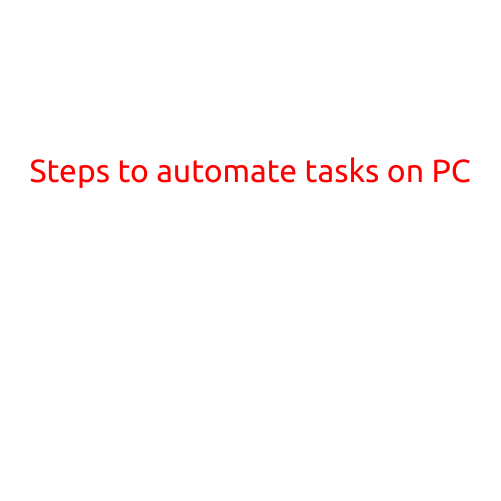
Steps to Automate Tasks on PC
Are you tired of performing the same repetitive tasks on your PC every day? Do you wish you had more time to focus on important tasks or simply take a break from work? Automating tasks on your PC can be a game-changer. With automation, you can save time, increase productivity, and reduce the likelihood of human error.
In this article, we’ll guide you through the steps to automate tasks on your PC using various tools and techniques. Whether you’re a beginner or an advanced user, you’ll find this article helpful in streamlining your workflow and getting more done in less time.
Step 1: Identify Tasks to Automate
The first step in automating tasks is to identify the tasks that can be automated. Look for tasks that are repetitive, time-consuming, or prone to human error. Some common tasks that can be automated include:
- Data entry
- File management
- backups and recovery
- Sending emails or notifications
- Running reports or generating documents
- Uninstalling or installing software
- Posting updates on social media
Step 2: Choose an Automation Tool
Once you’ve identified the tasks to automate, it’s time to choose an automation tool. There are many automation tools available, including:
- IFTTT (If This Then That): A web-based automation tool that allows you to create custom recipes.
- Zapier: A popular automation tool that integrates with over 1,000 apps.
- Automator: A built-in automation tool in Mac OS X that allows you to create custom automation workflows.
- AutoHotkey: A free scripting language that allows you to automate tasks on Windows.
- Python: A popular programming language that can be used to automate tasks on PC.
Step 3: Set Up Automation
Once you’ve chosen an automation tool, it’s time to set it up. This may involve creating an account, installing software, or setting up a workspace. The specific steps will depend on the tool you’ve chosen.
Step 4: Create Automation Workflows
Next, you’ll need to create automation workflows. A workflow is a series of actions that are triggered by a specific event or condition. Workflows can be as simple or as complex as you like, depending on the task you’re automating.
For example, you might create a workflow that automatically:
- Saves a file to a specific location
- Runs a report or generates a document
- Sends an email or notification
- Uninstalls or installs software
- Posts an update on social media
Step 5: Test Automation
Before you start using your automation workflow, it’s a good idea to test it to ensure it’s working correctly. Test your workflow by triggering the event or condition that is supposed to trigger the automation.
Step 6: Refine Automation
Once you’ve tested your automation workflow, it’s time to refine it. Refine your workflow by adjusting the triggers, conditions, and actions to ensure it’s working as intended. You may need to make adjustments along the way to ensure that your workflow is running smoothly.
Conclusion
Automating tasks on your PC can save you time, increase your productivity, and reduce the likelihood of human error. By following the steps outlined in this article, you can create custom automation workflows using various tools and techniques.
Remember to start small and gradually build up your automation workflows. With practice and patience, you’ll become a pro at automating tasks on your PC and will enjoy the benefits of increased productivity and reduced time spent on repetitive tasks.





